Hawaii is not typically associated with the vibrant fall foliage in many mainland US destinations. But if you want to experience a different side of Hawaii in the fall, there are a few lesser-known towns and locations where visitors can find a touch of autumn colors without encountering the usual crowds of tourists.
Traveling to less crowded towns in Hawaii also offers several advantages for visitors seeking a more peaceful and serene experience. Renowned for its natural beauty, less overcrowded areas offer visitors a glimpse of more pristine and unspoiled landscapes. Explore untouched beaches and hike through lush forests, and with fewer tourists around, you are more likely to spot wildlife in their natural habitats, like native birds and colorful marine life. Unique adventure opportunities, such as off-the-beaten-path hiking trails, water sports, and cultural explorations that are less crowded and more intimate are also more easily accessible.
So, while Hawaii's fall foliage may not be as dramatic as in New England or the Pacific Northwest, you can still enjoy the beauty of the changing seasons in any of these towns.
Waimea, Big Island
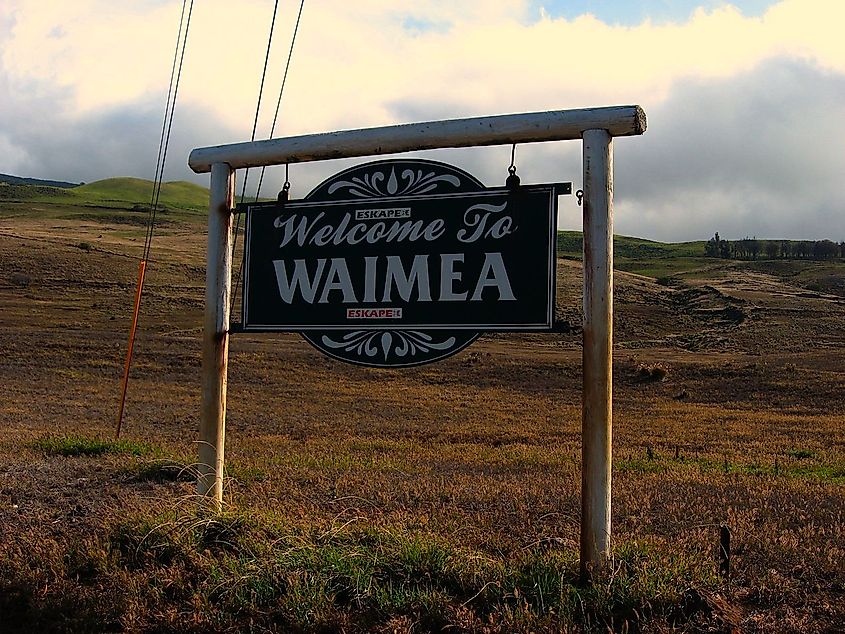
Located on the northern side of the Big Island (also known as the island of Hawaiʻi), Waimea (which means reddish water) is often called Kamuela by locals. Waimea, home to the Parker Ranch, is the home of paniolo (or cowboy) culture. The ranch, founded in 1847, is the oldest cattle ranch in the United States. The cattle ranch pre-dates many ranches in Texas and other southwestern states by over 30 years. The ranch spreads across 130,000 acres, and though once privately owned, it is now owned and operated by the Parker Ranch Foundation Trust. Its proceeds benefit area hospitals, communities, and schools.
In Waimea, you can witness the fall season with cooler temperatures and occasional rain showers that bring out green landscapes and autumn-like colors. Fall is one of the best times to visit Hawaii, as the weather is milder than the hotter summer months. The rainfall is slightly higher in the fall, but most rain occurs overnight, leaving the days clear, sunny, and warm. It is also less crowded this time of year compared with summer and winter, so there are fewer crowds, which translates into lower prices on flights, hotels, and rental cars.
The town hosts the annual Waimea Fall Festival and Parade, featuring a pumpkin patch, keiki games, and activities like face painting, inflatable bouncy castles, water slides, and a petting zoo. There will also be live entertainment, a craft sale, community information booths, and plenty of food.
An essential tip for first-time travelers to Waimea is to embrace the spirit of Malama, which means "taking care of” in Hawaiian. In Hawaii, malama is a way of life and means to protect the islands for future generations. Be careful to walk around fragile plant life, and avoid disturbing, touching, or sitting on coral. Hawaiian law also forbids visitors from taking coral home as a souvenir.
Volcano Village, Big Island
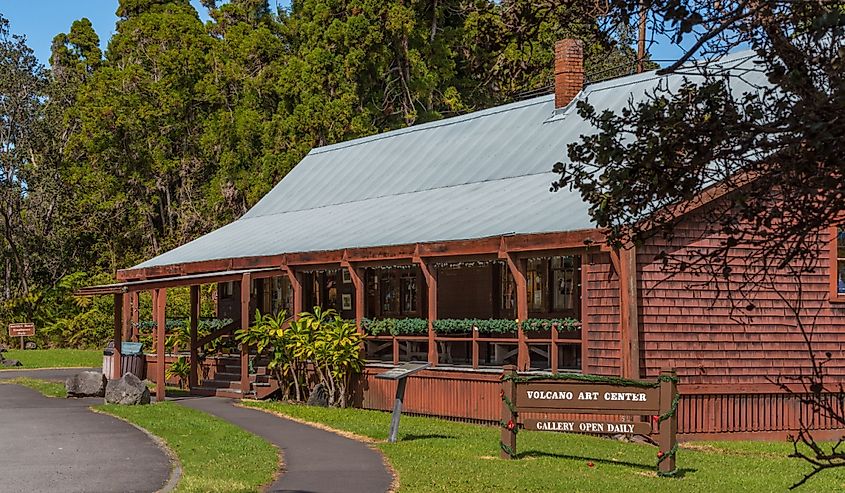
Located near Hawaii Volcanoes National Park, Volcano Village is a tranquil escape where you can explore lush rainforests and enjoy the fiery glow of the lava as it flows from the world’s most active volcano, Kilauea. The village rises nearly 4,000 feet above sea level, giving visitors a once-in-a-lifetime chance to witness a native Hawaiian rain forest and active volcano eruptions. Although you won't see traditional fall foliage in Volcano Village, the park's distinctive landscapes and cooler temperatures give it a distinct autumn-like vibe.
Volcano Village has a thriving artistic community, with several famous Hawaiian artists setting down roots under the majestic pine trees. You’ll find glass blowers, painters, and ceramic artists showcasing their work in many local galleries, and at the Volcano Art Center Gallery. Built in 1974, the gallery and the artistic community of Volcano Village attract artists, poets, dancers, and performance artists from around the world who want to practice their craft in the natural world.
In Volcano Village, you'll find some charming bed and breakfasts nearby, like the award-winning Volcano Bed and Breakfast, where guests enjoy a rainforest retreat in private lodges with wine, chocolate-covered pineapple, and a charcuterie board in the privacy of your room. The bed and breakfast also offers one-on-one classes in creating a lei, haku, or a lesson on performing a traditional Hula. If a romantic getaway is what you’re looking for, the Lotus Garden Cottages provide a luxurious, tranquil setting with all the amenities of a 5-star hotel, like a forest-side jacuzzi and a connoisseur breakfast.
Volcano Village is a short five-mile drive from the entrance to the Hawaiʻi Volcanoes National Park. If you plan to spend the day exploring the volcano, stock up on snacks, bottled water, a hat, sunscreen, and flashlights. Stay out of closed areas, do not hike after dark, and wear good shoes and long pants, as slipping on lava rock is like falling on shattered glass.
Kula, Maui
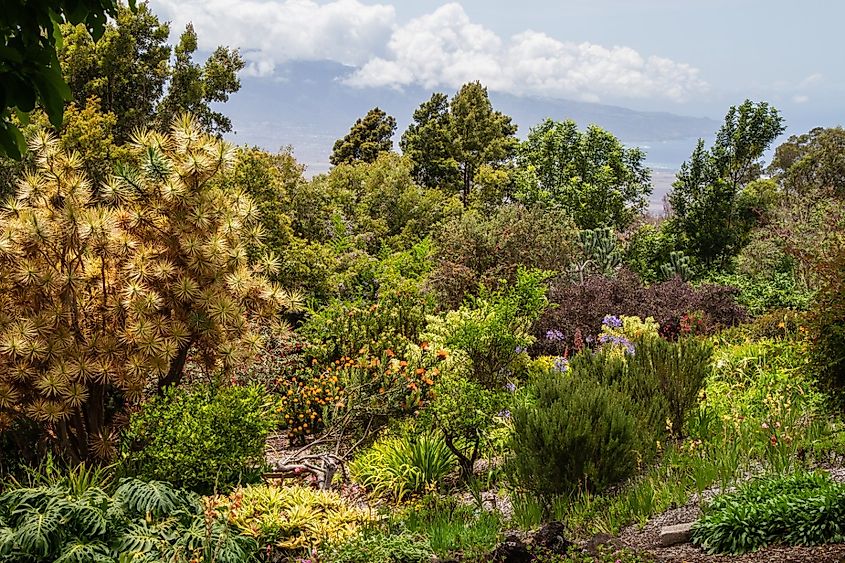
Kula is a small town with around 7,000 residents. Situated near the Haleakalā Volcano, Kula offers visitors an opportunity to witness the vibrant colors of the up-country. Visitors to Kula can enjoy the fall colors in the form of flowers and foliage. Several species of flowers, not native to the region, came from the Caribbean and Central and South America, like bright orange and red bougainvillea, Heliconia, and the iconic flower of Hawaii, the Hibiscus, which blooms year around in colors including orange, yellow, and red.
Haleakalā means "house of the sun" in Hawaiian, after its spectacular sunrises and sunsets. At 10,023 feet above sea level, Haleakalā is the largest dormant volcano in the world. The volcano's most recent eruption probably occurred between 1480 and 1600 CE, but that doesn’t mean it won’t erupt in the future.
Most visitors to Kula start the day early to drive to the Haleakalā Visitor Center to watch the sunrise. The center is open daily from sunrise to sunset. If you plan on hiking Haleakalā, plan ahead of time to reach the summit in time. You will want to aim for 1 hour before the listed sunrise time when the sun will break the horizon to see all the colors. Reservations are a must between 3:00 am and 7:00 am. Unless you book a guided tour, you must make a reservation before you go up. Dress warmly in layers as temperatures can reach freezing.
Remember when visiting Haleakalā that lava rocks are not souvenirs. They belong to Madame Pele, the famed Goddess of Volcanoes and Fire, and the notorious Pele’s Curse. As the legend goes, Madame Pele jealously guards her "children" (lava rocks) on the islands of Hawaii. Anyone foolish enough to take a volcanic rock will suffer irreparable bad luck until returned.
Festivals of Aloha begin in September and last throughout October. Although postponed this year, the Maui Country Fair, usually held yearly in the fall, gives visitors and locals a chance to celebrate Hawaiian culture. You can attend a lei-making class, listen to native Hawaiian music, and enjoy local delicacies while learning to hula.
Hanapēpē Town, Kauaʻi
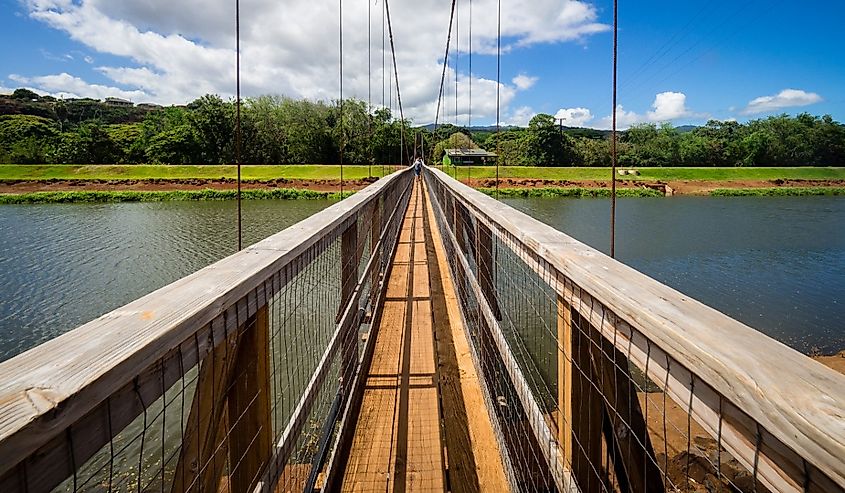
Hanapēpē Town was once one of Kaua’i’s largest communities. It was also one of the busiest towns with G.I.s and sailors stationed there from World War I to the 1950s. Known as " Kaua’i's Biggest Little Town," it offers a relaxed ambiance and flora that resembles fall foliage. It's a quieter spot on the Garden Isle.
Considered the "art capital" of Kaua’i, the vibrant town celebrates its artists every Friday night from 6:00 to 9:00 pm, who are more than happy to swing open the doors of their studios and galleries to invite visitors inside. Another top attraction is the Hanapēpē Swinging Bridge, a pedestrian suspension bridge that spans the Hanapēpē River. The bridge is suspended by steel cables and wooden planks. Plantation workers built the bridge during the 20th century to provide access for the workers between the town and the fields.
Visitors to Hanapēpē Town can stay in historic, quaint plantation homes with full kitchens, backyards full of mango trees in season, and BBQs offer private and pretty accommodations. There’s a local brewery, the Kaua’i Island Brewing Company, where visitors will discover great local beer and Pacific Rim cuisine.
Waikoloa Village, Big Island
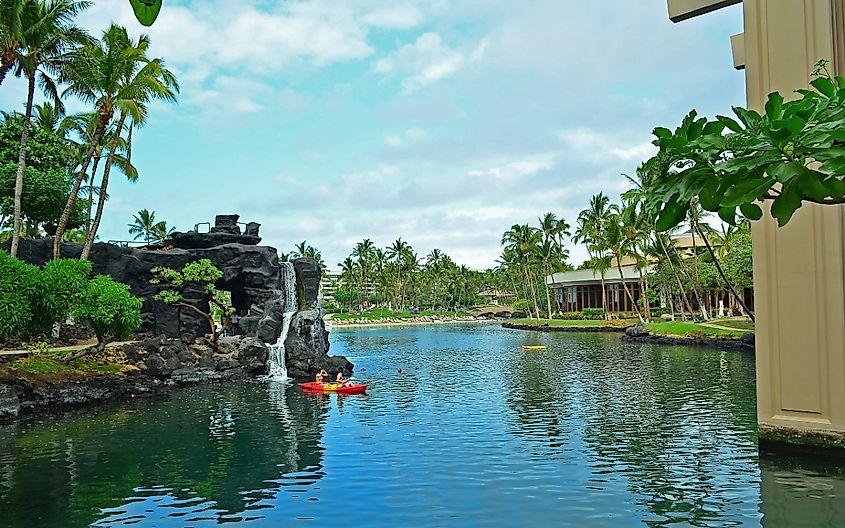
Waikoloa Village offers majestic views of the Kohala Coast and nearby volcanoes: Mauna Kea, Mauna Loa, Kohala, and Hualālai. At higher elevations, Waikoloa Village enjoys a cooler climate and some fall-like vegetation changes. While the best time of year to visit the village and enjoy its warm climate is late May to early October, the weather is tropical all year round.
Primarily a resort destination, the village was built on top of a lava field with the towering volcano of Mauna Kea 30 miles away. Like many volcanos on the Big Island, Mauna Kea is currently dormant, but past eruptions created a path to the ocean. The beaches of Waikoloa Village feature lava rocks, coral, and blue-green waters.
The village has many popular resorts; the Hilton Waikoloa Village hosts various cultural events and activities, such as the Big Island Film Festival and the Kona Brewers Festival. The famous Ironman Triathlon World Championship is held annually in nearby Kona on the Big Island.
Plenty of boat tours in and around Waikoloa Village include glass-bottomed boat cruises, sunset sailing, and snorkel and dolphin watches aboard luxury catamarans. Helicopter tours are highly rated as the ultimate sightseeing experience. Blue Hawaiian Helicopters has been flying visitors over the Big Island since 1985 and promises to deliver an authentic Aloha experience. Or hop on an e-bike available at Big Island Personal Tours, take a self-guided GPS tour around the Waikoloa Resort area, and visit the Petroglyph reserves and black sand beaches at your own pace.
Waimānalo, O’ahu
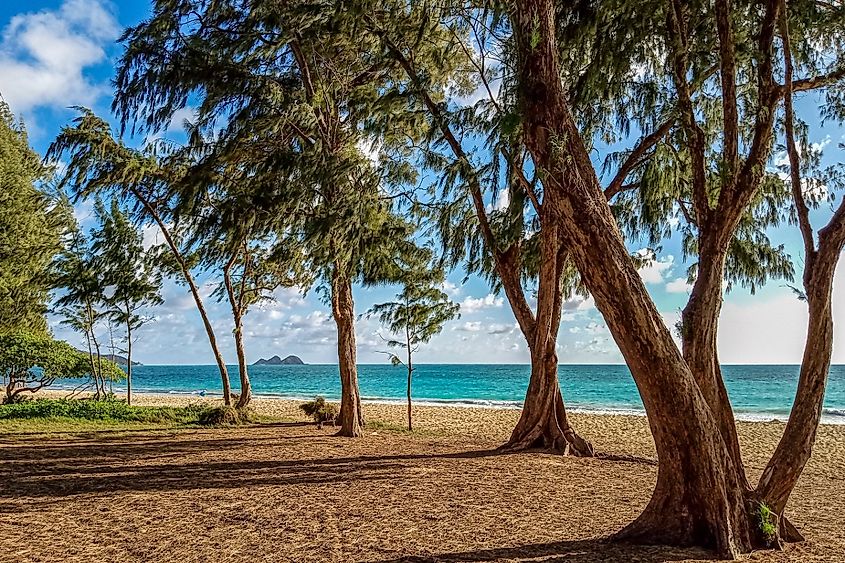
While O’ahu is often bustling with tourists, Waimānalo on the island's eastern side offers a calmer, less frequented experience. The town is known for its beautiful, uncrowded beaches and the stunning Ko'olau Mountains in the background, creating a quiet atmosphere to enjoy in the fall.
Every year, the small town of Waimānalo, with a population of 5,599 residents, hosts the Waimānalo Country Farms’ Fall Harvest Festival. There is a pumpkin patch, fields of sunflowers, and a country market where you can purchase their famous fresh squeezed lemonade, farm honey, handmade crafts, cornbread, and more. Pricing for a day at the festival runs around $16 per person and includes tractor hayrides, a visit to the sunflower field, photo opportunities in the pumpkin patch, animal visits, and an activity zone for the keiki (or kids). Waimānalo Country Farms also hosts private picnics in the pumpkin patch and the sunflower fields.
There are numerous beautiful beaches in and around Waimānalo. The Waimānalo Beach, with its powder-soft sand, turquoise waters, and waves perfect for boogie boarding, is relatively crowd-free during the week compared to crowded nearby Waikiki Beach.
Lana'i City, Lana'i
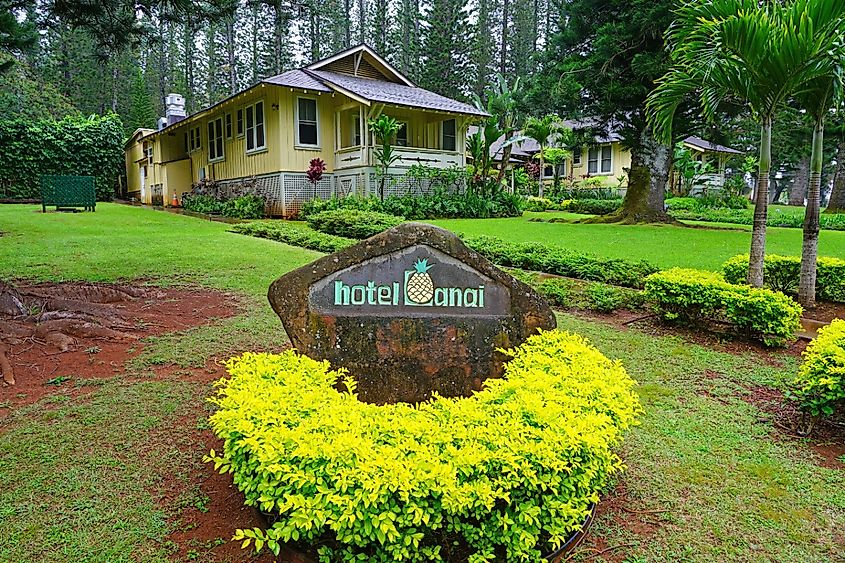
While Lana'i is a less-visited island, it offers stunning landscapes to explore. Often referred to as "Pineapple Island" because of its history of pineapple farming, Lana’i is home to only 3,000 residents, making it one of Hawaii’s most remote and secluded islands. The island's current owner is Larry Ellison, the billionaire who co-founded the software giant Oracle Corp., who renovated the island in 2012 to introduce a more modern luxurious feel while maintaining its unspoiled remote atmosphere.
Lana’i has no traffic lights, and only 30 miles of paved roads are on the island. So, renting a 4x4 Jeep and going off-roading is an ideal way of exploring the island’s landscape. Download the free Lana’i Guide App and use its interactive maps, photographs, and more.
There are limited options if you plan on staying overnight on the island. The five-star, five-diamond Four Seasons Resort Lana’i on Hulopoe Bay epitomizes decadence, while the 11-room Lana’i Hotel, or the Sensei Lana’i, is slightly more affordable. There are also quite a few rental properties and Bed & Breakfasts available.
These seven small towns in Hawaii provide a different perspective on autumn and a chance to escape the crowds while enjoying the islands' beauty. The fall foliage in Hawaii is not as vibrant or widespread as in many other parts of the United States, and you won't experience the same dramatic color changes, but fall in Hawaii is still stunning. These locations are among the best options for observing fall colors while enjoying a quieter, less crowded experience.
"crowded" - Google News
October 22, 2023 at 04:11AM
https://ift.tt/Y2TIRd6
7 Least-Crowded Towns In Hawaii To Catch Fall Foliage - Worldatlas.com
"crowded" - Google News
https://ift.tt/aYfpZ6g
https://ift.tt/MrLqyYS
Bagikan Berita Ini

















0 Response to "7 Least-Crowded Towns In Hawaii To Catch Fall Foliage - Worldatlas.com"
Post a Comment